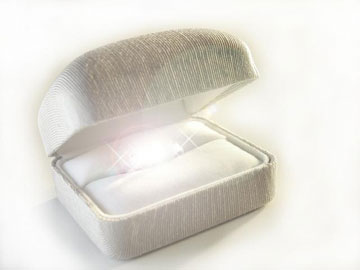 by Preston MacDougall July 31, 2007
A Chicago company, LifeGem, claims to be able produce multiple high-quality diamonds - up to a full karat in size - from the carbon contained in the bodies of people or pets. Color is a final resting option as well, since impurities, such as boron and nitrogen, give color to diamonds, including the famous Hope diamond.
Note that if you are thinking of including this chemical transformation in your "last will and testament", prior cremation greatly reduces the sparkling yield since most of your carbon atoms will go up the smokestack as CO2 molecules. LifeGem's process apparently involves "carbonization" as the first step. I don't know the details, but I am pretty sure that it is irreversible - unlike Han Solo's temporary carbon freeze when the Empire struck back - so have your executor make sure you're dead first. This process is similar to a common chemistry lab that demonstrates why carbohydrates are so-named. After mixing a few tablespoons of a carbohydrate, such as sugar, with concentrated sulfuric acid, not much seems to happen. After a while, however, things start to heat up, and steam can be seen rising from the mixture. The hot gas escaping was the "hydrate" part of the sugar, and what is left behind is the "carbo" part. Concentrated sulfuric acid catalyzes this dehydration reaction, which only partly undoes the photosynthetic work of the beets or sugarcane. To get from the black mess of the most common form of elemental carbon, to the prized transparency of diamond also requires a catalyst, but you will need more than just a beaker to let it do its job. During the '50s, GE used an iron-based catalyst to convert carbon in its abundant graphite form, into the first laboratory-made diamonds. To make the reaction "go", very high temperatures and a pressure 70,000 times normal atmospheric pressure had to applied. This necessitated the use of a powerful steel hydraulic press, and I presume similar equipment will be used if you and your relatives decide to start a collection of "family jewels". I was reminded of this chemistry when I read the obituary of one of Toronto's most colorful icons - Ed Mirvish, better known as Honest Ed. As a young boy, Ed Mirvish moved with his family from Virginia to Toronto in 1923. In 1948, he and his wife cashed in a small insurance policy to start Honest Ed's, a popular spot for bargain hunters at the uptown intersection of Bloor and Bathurst Streets. His penny-pinching emporium isn't what reminds me of diamonds however. It will require further chemical research on optimal catalysts before synthetic diamonds are that inexpensive. No, it was his subsequent business ventures in the arts that prompted the comparison. In 1962, when Honest Ed bought it at a bargain price, the Royal Alexandra Theater in downtown Toronto was in sad shape. It had seen better days since it opened in 1907. One-hundred years later, the "Royal Alex", as most Torontonians call it, is one of the city's cultural gems - putting on sell-out shows, such as "Mamma Mia!", one after the other. In this case no iron-based catalysts were used, but there was perhaps a little pressure from Ed's wife Anne, who was an avid art lover. Once, when he was asked how he would like to be remembered, Ed jokingly said "I would like to erect a huge throne in the centre of Honest Ed's retail store. I would then like my body cremated and the ashes put in an hourglass. I would then like someone sitting on the throne to keep turning the hourglass up and down, up and down, and the employees would point to the hourglass and say, "There's Ed. He's still running!" I don't know whether or not he modified this joke after learning about the new chemical options for one's remains, but no matter what happens to his body, his colorful and radiant influence on Toronto remains.
E-mail your letters & opinions to editor@sitnews.us SitNews ©2007 Stories In The News Ketchikan, Alaska |
||
